THE NEAL ADAMS CHRONICLES: A birthday tribute to the Man of Steel’s co-creator…
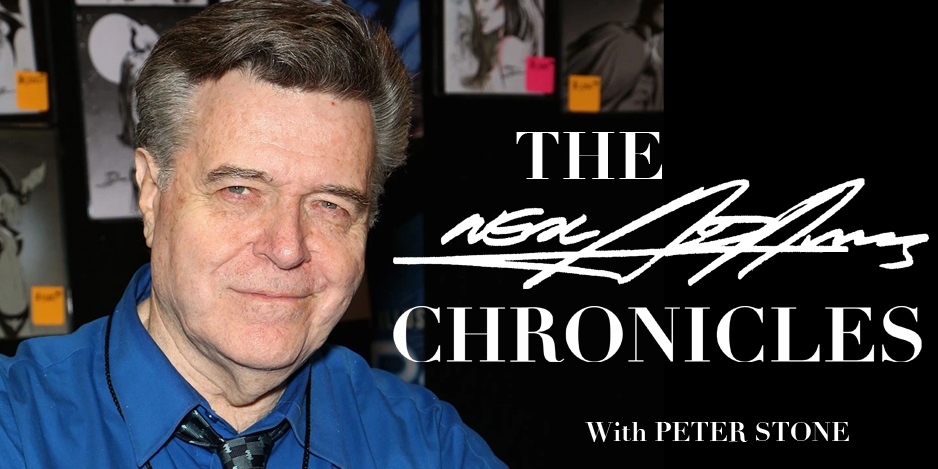
By PETER STONE
“Look! Up in the sky! It’s a bird! It’s a plane! It’s Superman!”
Although this quote came from the 194os radio show, it has become as iconic as the image of Superman breaking chains by Neal Adams. Which leads us quite quickly to the connection between Neal Adams and Jerry Siegel. Jerry Siegel was, of course, half of the creative team that gave us the greatest hero in the entire superhero pantheon. He was born 109 years ago, on Oct. 17, 1914 in Cleveland. Neal was one of the greatest, most commercial artists the comic industry has ever seen. He was born in 1941 on Governor’s Island, in an Army hospital. Jerry opened the world to superheroes through his knowledge of myths in the form of Superman, Clark Kent, the Daily Planet and Lois Lane, while Neal, perhaps a real-life “strange visitor from a another planet with powers and abilities far beyond those of mortal men,” gave the comic world a new illustrative look, and stood up for creatives in a way that Superman might — especially Jerry Siegel and Joe Shuster.
They were drawn together like planet-size magnets.
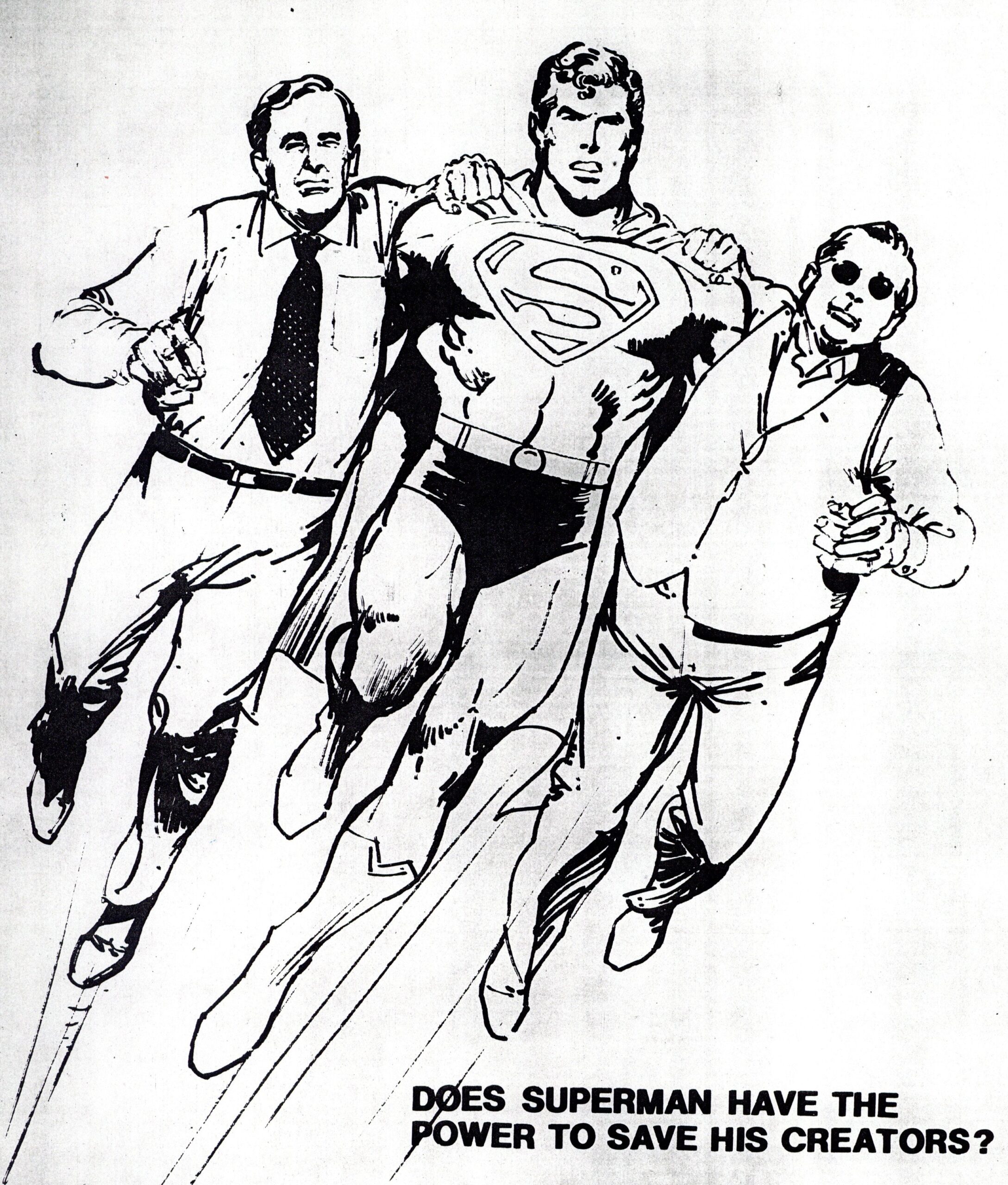
Jerry Siegel, Superman, Joe Shuster, by Neal Adams
This is a story that many people may have already heard, but there may be a few tidbits and dates people may not know. This is a moment in time connecting Jerry Siegel and Neal Adams. That is my personal, closest connection to Jerry. That, and Neal talking about the struggle against DC. Jerry Siegel, above and beyond his co-creation of Superman, also co-created Slam Bradley, the Spectre, the Star-Spangled Kid and Stripsey, as well as Legion of Super-Heroes characters Bouncing Boy, Brainiac 5, Triplicate Girl, Invisible Kid, Matter-Eater Lad, Phantom Girl, Chameleon Boy, Lightning Lord and Saturn Queen. He received no byline for the later Legion stories as was the policy at the time. Those characters, unfortunately, are dwarfed by his first and most popular co-creation. This story reveals one of Superman’s greatest battles… as well as that of Jerry Siegel and Neal Adams and Jerry Robinson.
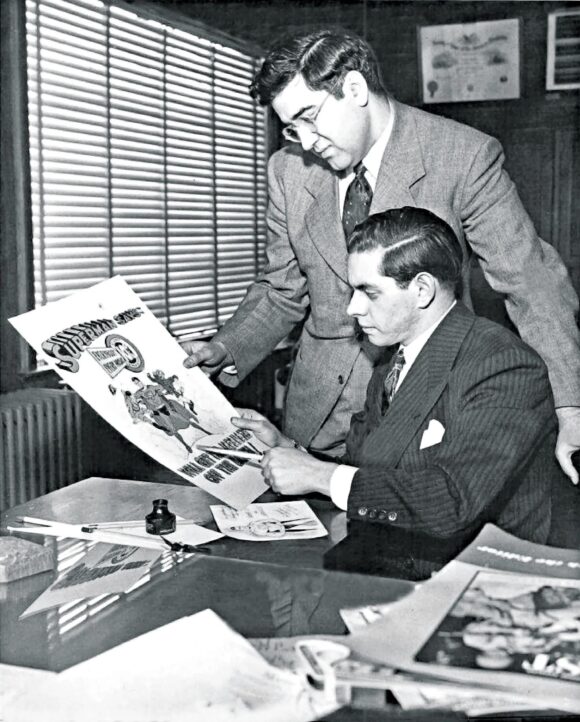
Shuster (top) and Siegel
Siegel said he and Joe Shuster thought of the idea of Superman during the Depression, inspired by President Roosevelt’s fireside radio chats. They sensed the hopelessness and fear in the country and wondered if there was a way to help the despairing masses. Their answer – Superman! And boy did it work.
However, they’d sold their character to Detective Comics Inc. for $130 before they started creating the Superman comics. The two were paid $5 a piece per page as the Man of Steel caught on across America, inspiring a host of other superheroic characters. (In the early 1940s, Superman sold over a million copies monthly.) Detective Comics Inc./National Periodical Publications, however, brought to bear the overwhelming might of their legal power and through attorneys, agents, taxmen, lawsuits and countersuits, ensured the Man of Steel belonged to them and them alone. Jerry and Joe had no rights and would receive no money, beyond work they did on individual comics.

Then, in the early 1970s, more than 30 years after the creation of the Man of Steel, Jerry Siegel was working as a civil service clerk-typist for the state of California. He made $7,000 a year, had no savings account, and could not afford to buy a car. He was ill, broke, spent his days sorting letters in a mailroom and tried, in his own words, not to go crazy. His creation, Superman, meanwhile had serials, radio programs, television shows, animation, t-shirts, pajamas, toys, bedsheets, and products of every possible kind accruing millions upon millions upon millions of dollars from the creation of a 19-year-old writer and his artistic partner. Jerry Siegel and Joe Shuster realized not a single penny.
Cut to 1975. A young Neal Adams, recently on strike from DC and Marvel Comics over work-made-for hire contracts, was petitioned by Jerry Siegel to possibly help them fight the company that now owned Superman – Warner Bros. Neal, having been struggling against DC to give creators better rights and more money, agreed to help.
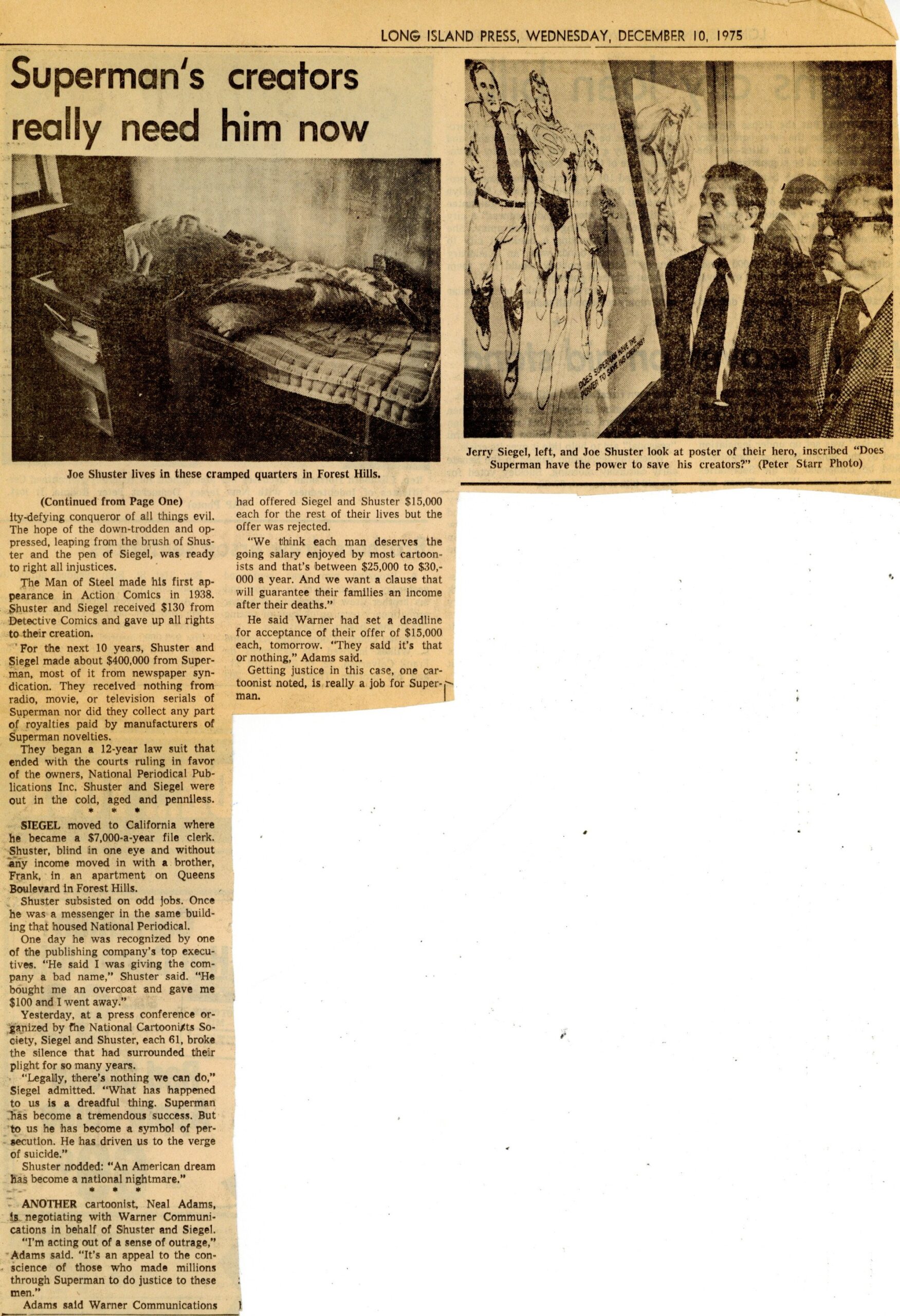
No longer relying on comics, Neal was firmly enmeshed in advertising work and his burgeoning company, Continuity Graphics. As many are aware, well-known and talented comic artists made extra money drawing storyboards and pre-production animatics. Advertising provided more money per frame than any comic book panel. Neal was happy to provide extra money for artists… and getting help with the drawing didn’t hurt either. However, fighting a huge company like Warner Bros. would take a tremendous amount of time and energy.
Siegel, Shuster and Neal’s arch-nemesis was a man named Jay Emmett, the executive vice-president of Warner Communications. His quote about the entire battle was, “Of course, we have no legal reason to do anything for Mr. Siegel or Mr. Shuster.” However, for reasons of “morality and compassion” Warner Communications was considering making some kind of offer.
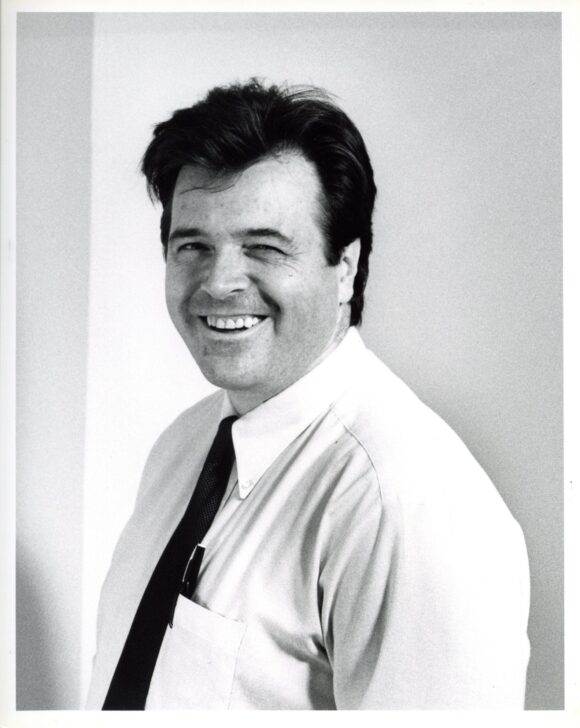
Over the length of the legal battle, Neal wrote hundreds of letters, talked to lawyers on both sides, and provided many interviews about the situation. Perhaps the most successful campaign waged against Warner Bros. was Neal and those closest to him contacting newspapers everywhere. Articles about the plight of Jerry Siegel and Joe Shuster started to appear across the country. Biting indictments of Warner Bros. appeared in print. One of the articles said that between the years of 1938 and 1948 when Jerry and Joe wrote and drew the comics, they made $200,000. After taxes, that equals out to about $12,000 a year. After that, they received nothing.
Finally, Warner Bros. offered a settlement of $15,000 a year, but Neal, with sweat pouring down his brow and soaking his shirt, rejected the offer. “We think each man deserves the going salary enjoyed by most cartoonists and that’s $25,000 to $30,000 a year. AND we want a clause that will guarantee their families an income after their deaths.” Warner Bros. set a deadline for acceptance of their offer… the next day. Neal claimed, “They said it’s that or nothing.” Now with the nervous sweat came sleepless nights and blown advertising deadlines. Neal came very close to losing everything he had worked so hard to achieve. However, like Superman, he would not give in to what he perceived to be evil.
Neal petitioned the art community to get involved and many groups spoke out about this injustice, including the Association of American Editorial Cartoonists and the Academy of Comic Book Arts. There were many working artists, however, who were afraid to speak out for fear they would never be able to work at DC Comics again.
Then, Goliath was finally toppled.
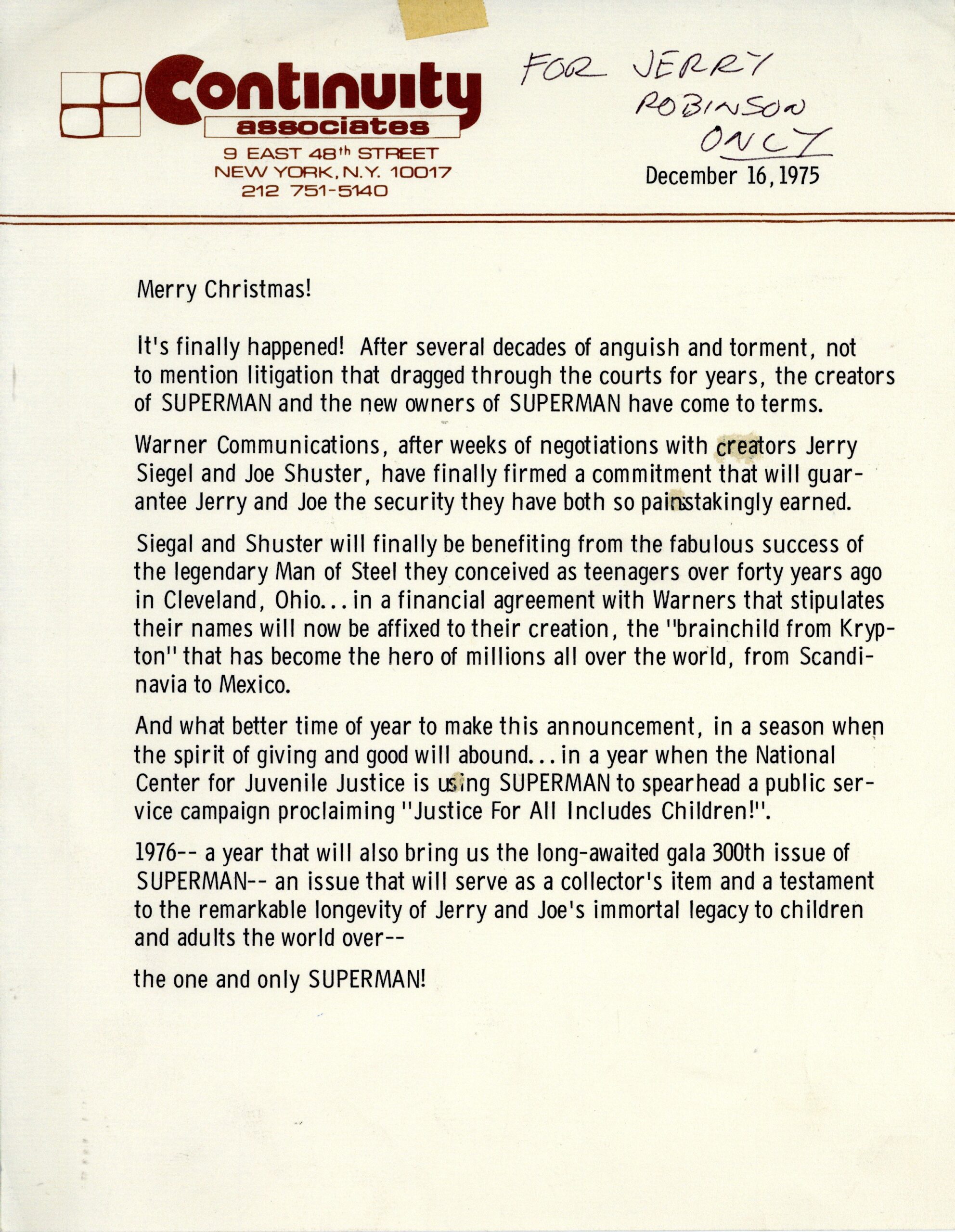
Emmett and Warner Communications gave in to the growing media pressure, giving Jerry Siegel and Joe Shuster $20,000 a year for the rest of their lives. Standing next to his friend and writing partner, Jerry Siegel, Joe Shuster said, “Now we can start living again. This will be a wonderful Christmas, a wonderful Christmas.” Jerry and Joe also received $17,500 as a signing bonus. Emmett, who claimed that Warners had no legal reason to give the men anything more than what was agreed to in the original contract, did so “in recognition of their past services and out of concern for their present circumstances.”
Neal and Jerry Robinson — co-creator of Robin, the Joker and Alfred the butler, as well as a staunch advocate for creators’ rights — were present at the signing of the deal, indicating their involvement in this epic battle.
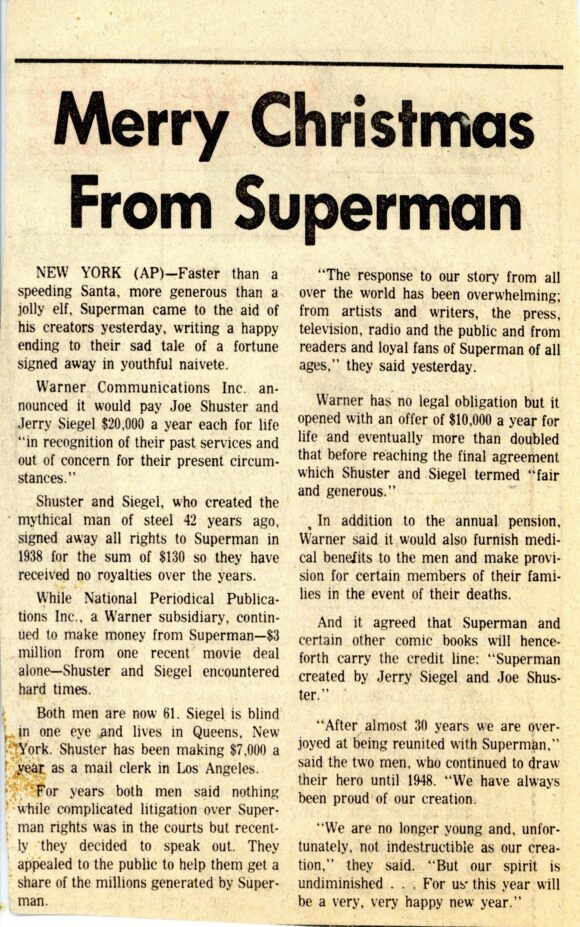
Jerry Siegel hand-wrote a letter to Neal, thanking him for his dedication. A man notorious for keeping little, Neal held onto this letter, speaking of it with great fondness. Perhaps the greatest Superman artist and the co-creator of the Man of Steel had banded together to topple a media giant using truth and justice.
The story, though, didn’t end there.
In 1975, Warner Bros. was in the midst of pre-production on the most expensive movie to date – Superman. The budget was $55 million, a mere pittance compared to today’s superhero budgets; it was to star Marlon Brando, Gene Hackman, Ned Beatty, Jackie Cooper, Glenn Ford and an unknown Christopher Reeve. Released in December 1978, Superman: The Movie went on to draw $300.5 million, making it the highest grossing movie of 1978 and the sixth highest grossing movie of all time. (Although it was planned to be released on the 40th anniversary of Action Comics #1 in spring 1978, the release date had to be pushed back due to problems during filming.)
Jerry Siegel and Joe Shuster’s monumental creation had proved what everyone already knew: Superman was the world’s greatest superhero.
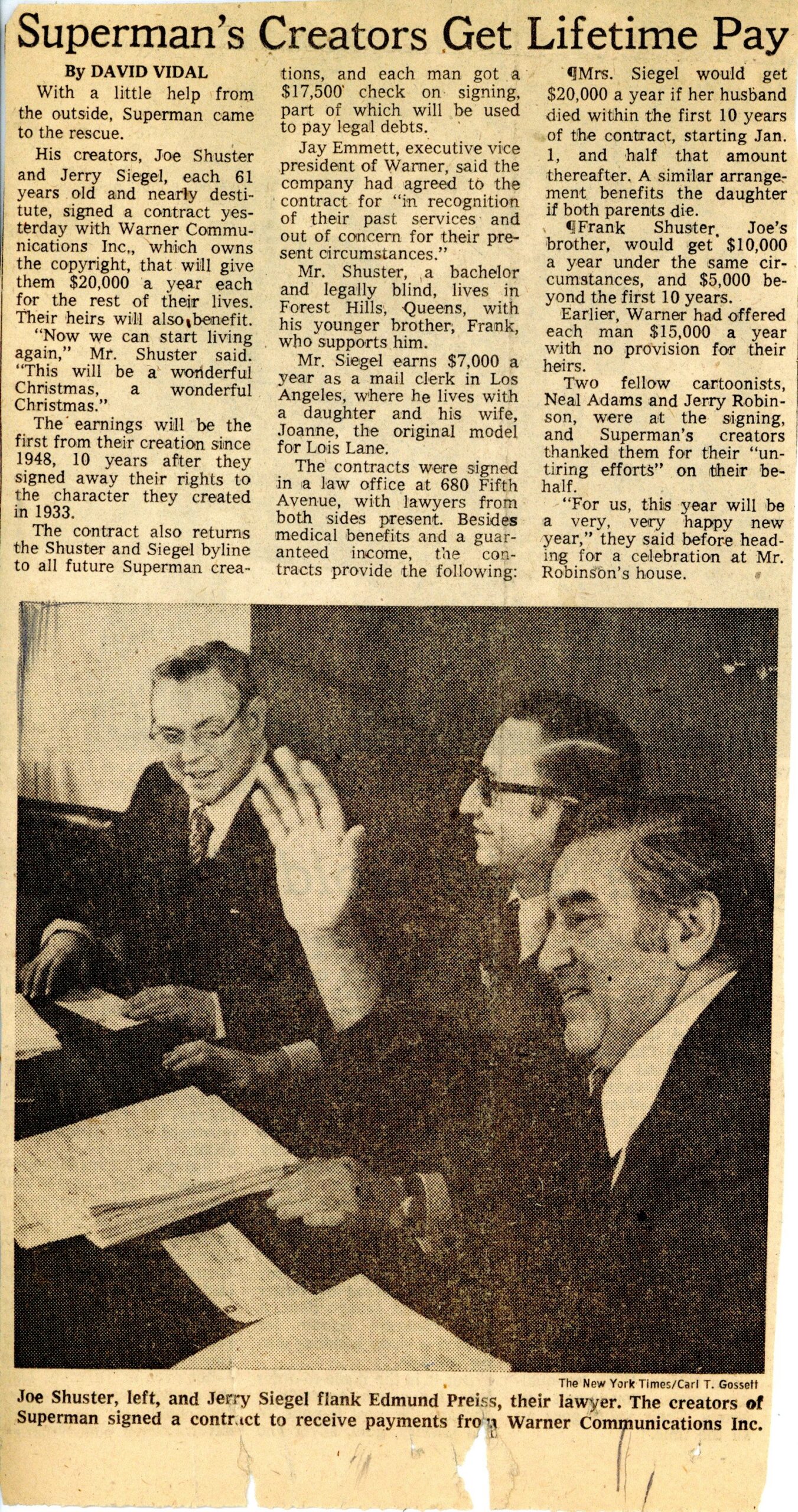
After Jerry’s death in 1996, his wife, Joanne (the model for Lois Lane) continued the battle and attempted to get the copyright for Superman. In 1999, she and her daughter filed a lawsuit to garner the rights to Superboy. In 2004, the court ruled in their favor and then later even said Smallville infringed on their copyright. Then in 2008, a federal court in Los Angeles restored Jerry’s United States co-authorship of Superman. DC retained the international rights.
Superman was finally back where he belonged. With his co-creator and “family.”
Neal, inspired by his belief in fairness and that creatives should be able to live a decent life, raise children and get a piece (maybe a small piece) of their character when it becomes a TV show, movie or toyline, continued to help when asked. He got work for up-and-coming artists, pencilled a job for an inker who needed work, spoke out and helped artists like William Messner-Loebs and Dave Cockrum, reached into his own pocket to lend money to artists and writers who were desperate. The battle for Jerry Siegel and Joe Shuster may be one of the most visible altruistic acts from Neal Adams, but sometimes even Superman saves the world and no one ever sees it.
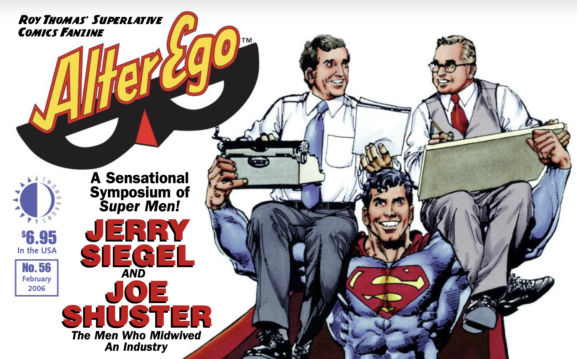
Jerry Siegel and Joe Shuster gave the world perhaps its greatest hero. A naturalized Earthling who stands for the greatest forms of Truth and Justice. (Every 5-year-old little boy — Black, white, Latino or Asian, at some point, wants to dress up as the Man of Steel for Halloween.) Combined with arguably the greatest cover artist in DC Comics’ history, Neal Adams, and the co-creator of the Joker, Jerry Robinson, the right things were eventually done.
“There is a superhero in all of us, we just need the courage to put on the cape.” – Superman and Lois
—
MORE
— JOE KUBERT AND NEAL ADAMS: Two Artists, Two Friends, Two Legends. Click here.
— Mapping Out NEAL ADAMS’ Enduring Respect and Admiration for JACK KIRBY. Click here.
—
Peter Stone is a writer and son-in-law of the late Neal Adams. Be sure to check out the family’s twice-weekly online Facebook auctions, as well as the NealAdamsStore.com, and their Burbank, California, comics shop Crusty Bunkers Comics and Toys.

October 17, 2023
Excelente artículo e información
October 17, 2023
What a truly touching story. I feel so blessed to have read it.
October 18, 2023
Great article! And a testament to what a decent man Neal Adams was (and Jerry Robinson, too). The news clips provide added context.
October 18, 2023
The work of all three gentlemen has impacted my life (not just my creative life) immensely. God bless everyone who went to bat for Jerry and Joe (if I may be so informal!) Thank you, Neal! And thank you Peter!